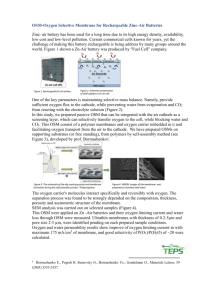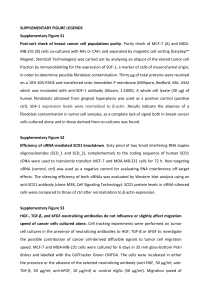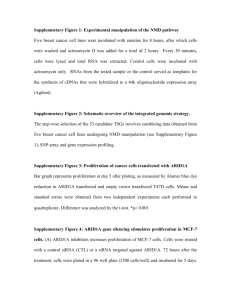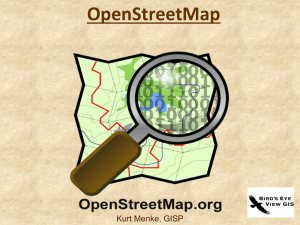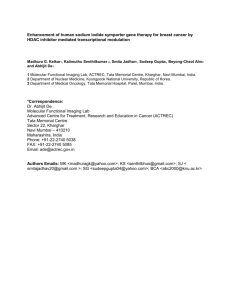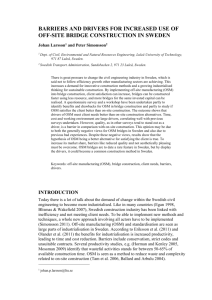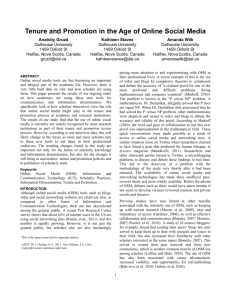Supplementary Information (doc 50K)
advertisement
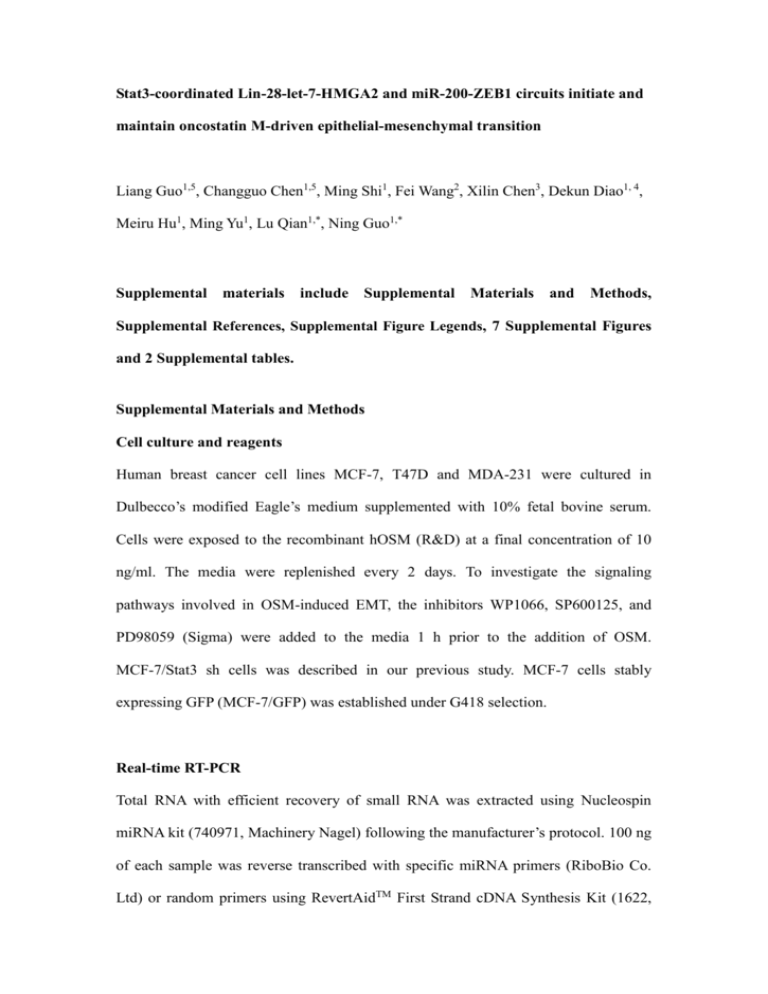
Stat3-coordinated Lin-28-let-7-HMGA2 and miR-200-ZEB1 circuits initiate and maintain oncostatin M-driven epithelial-mesenchymal transition Liang Guo1,5, Changguo Chen1,5, Ming Shi1, Fei Wang2, Xilin Chen3, Dekun Diao1, 4, Meiru Hu1, Ming Yu1, Lu Qian1,*, Ning Guo1,* Supplemental materials include Supplemental Materials and Methods, Supplemental References, Supplemental Figure Legends, 7 Supplemental Figures and 2 Supplemental tables. Supplemental Materials and Methods Cell culture and reagents Human breast cancer cell lines MCF-7, T47D and MDA-231 were cultured in Dulbecco’s modified Eagle’s medium supplemented with 10% fetal bovine serum. Cells were exposed to the recombinant hOSM (R&D) at a final concentration of 10 ng/ml. The media were replenished every 2 days. To investigate the signaling pathways involved in OSM-induced EMT, the inhibitors WP1066, SP600125, and PD98059 (Sigma) were added to the media 1 h prior to the addition of OSM. MCF-7/Stat3 sh cells was described in our previous study. MCF-7 cells stably expressing GFP (MCF-7/GFP) was established under G418 selection. Real-time RT-PCR Total RNA with efficient recovery of small RNA was extracted using Nucleospin miRNA kit (740971, Machinery Nagel) following the manufacturer’s protocol. 100 ng of each sample was reverse transcribed with specific miRNA primers (RiboBio Co. Ltd) or random primers using RevertAidTM First Strand cDNA Synthesis Kit (1622, Fermentas). The expression levels of the miRNAs including let-7b/d/e/g, miR-200b/c and pri-let-7 were determined by real-time PCR using SYBR Green (600882, Agilent Technologies). The experiments were performed in duplicate. Luciferase reporter assays Cells seeded in 24-well plates were transfected with a cocktail of 300 ng of the reporter plasmid, 30 ng of the plasmid pRL-TK containing the Renilla luciferase reporter gene and 0.5 μg of the Stat3C expression plasmid or 20 pmol of the miRNAs. After 36 - 48 h, cell lysates were prepared and the luciferase activities were determined by a luminometer as described in our previous study. All transfections were carried out in duplicate and repeated at least twice. OSM expression in M1- and M2-polarized THP-1 macrophages THP-1 cells were obtained from ATCC and cultured in RPMI 1640 with 10% FCS. To generate PMA-treated THP-1 macrophages, 1 × 106 THP-1 cells were treated with 320 nM PMA for 48 h. M1- and M2-polarized macrophages were generated as described previously1. Briefly, 1 × 106 THP-1 cells were treated with 320 nM PMA for 6 h and then cultured with PMA plus 20 ng/ml IL-4 and 20 ng/ml IL-13 (for M2 polarization) or plus 100 ng/ml LPS and 20 ng/ml IFN-γ (for M1 polarization) for another 42 h. Wound healing assays MCF-7 cells were seeded in 96-well plates in triplicate and grew to a confluent of 80 90%. A linear wound was incised in the central area of the monolayers by a pipette tip, followed by washing and treatment with 10 ng/ml of OSM or PBS. Images of the wound area were taken at 24 h and 48 h after OSM stimulation, respectively, using an Olympus CKX41 microscope. In vitro cell invasion assays The invasive capability of the cells was examined in 24-well plates with 8 μm-pore-size polycarbonate inserts (3422, Costar) coated with MatrigelTM Basement Membrane Matrix (354234, BD Biosciences). 2×105 MCF-7 or 1×105 MDA-231 cells were plated on the inserts in the serum-free medium and 20% FBS-containing media were added to the lower compartments. After culture at 37°C for 10 h (MDA-231 cells) or 48 h (MCF-7 cells), the cells that invaded through Matrigel were stained with Sulforhodamine B (SRB, S1402, Sigma), photographed under an Olympus CKX41 microscope and finally reconstituted in 10 mM Tris solution to quantify the invasion by measuring absorbance at 570 nm on a Multiskan FC Machine (Thermo Scientific). The experiment was repeated twice. Immunofluorescence staining Cells were seeded on coverslips in six-well plates. After miRNA transfection for 24 h, the cells were treated with PBS or OSM. Then transfection was repeated once every 2 days during OSM treatment. The cells were permeabilised and fixed with 100% methanol at -20°C for 10 min followed by quenching with tris-buffered saline (TBS) containing 0.1% sodium tetraborate. Then the cells were blocked at room temperature for 1 h in PBS containing 3% BSA and subsequently incubated with the primary antibodies overnight at 4°C. After washing with TBS, the cells were incubated with the fluorescence-conjugated secondary antibodies for 1 h at room temperature. Fluorescence images were collected under a laser scanning confocal microscope (Zeiss LSM510). Supplemental References 1. Tjiu JW, Chen JS, Shun CT, Lin SJ, Liao YH, Chu CY et al. Tumor-associated macrophage-induced invasion and angiogenesis of human basal cell carcinoma cells by cyclooxygenase-2 induction. J Invest Dermatol 2009; 129: 1016-1025. Supplementary Figure legends Figure S1. OSM was expressed at the invasive front in invasive breast cancer tissues. Figure S2 M2-polarized THP1 macrophages express high levels of OSM. A and B, A large amount of OSM-expressing inflammatory cells aggregated around the tumor sinusoids (A) and inflammatory lesions (B). C, The procedure of generation of M1and M2-polarized THP1 macrophages. D, The secretion of OSM by macrophages was analyzed by ELISA. Figure S3 OSM induced the mesenchymal phenotype and expression of the proinvasive and prometastatic genes in breast cancer cells. A, T47D cells were treated with 10 ng/ml OSM for 5 day and the expression of E-cadherin, fibronectin, vimentin, ZEB1 and Snail was analyzed by Western blot at the indicated time points. B, MCF-7 cells were treated with 10 ng/ml of OSM for 5 days. The morphological changes of the cells were observed under an inverted microscopy. Bar = 100 μm C, The expression of the pro-invasion and pro-metastasis genes was analyzed by RT-PCR at the indicated time points. Figure S4 let-7 and miR-200 reverse OSM-induced phenotype transition. MCF-7 cells were transfected with let-7b/d/g and miR-200b/c. After transfection for 24 h, the cells were treated with 10 ng/ml of OSM for 5 days. The expression of E-cadherin and fibronectin was determined by immunofuorescence/confocal microscopy. Figure S5 OSM activated Stat3 signaling pathway. A, MCF-7 cells were transfected with the luciferase reporter vectors containing the consensus binding sequences for AP-1, Stat3, NF-κB or Smad. After transfection for 24 h, the cells were treated with 10 ng/ml of OSM for an additional 24 h and then luciferase assays performed. B, MCF-7 cells were pre-treated with MEK1 inhibitor PD98059 (25μM), JNK inhibitor SP600125 (10 μM) and Jak/Stat inhibitor WP1066 (2.5 μM) for 1 h and then exposed to 10 ng/ml of OSM. The expression of E-cadherin, fibronectin, ZEB1 and p-Stat3 was analyzed by Western blot. Figure S6 Knockdown of Stat3 affects the expression of let-7 and miR-200. A, The expression of let-7e and miR-200c in MDA-231/Stat3 sh cells was analyzed by real-time RT-PCR. B and C, Schematic presentation of the constructs pLuc-HMGA2 and pLuc-ZEB1, which contain the 3′ UTRs of HMGA2 and ZEB1, respectively. Seven conserved sites complementary to let-7 in the 3′ UTR of HMGA2 and five putative miR-200b/c seed matches in the 3′ UTR of ZEB1 are indicated (upper panels). MCF-7 cells were co-transfected with pLuc-HMGA2 3’UTR and let-7b/d/g or with pLuc-ZEB1 3’UTR and miR-200b/c. The repressive effects of let-7 and miR-200 on the HMGA2 and ZEB1 3’ UTRs were confirmed by luciferase assays (lower panels). Figure S7 Stat3 upregulated the expression of HMGA2 in breast cancer cells. MCF-7 cells were transfected with the Stat3C expression plasmid. A, The transcription of HMGA2 gene was analyzed by real-time RT-PCR. B, The expression of HMGA2 and Flag-Stat3C was analyzed by Western blot.
